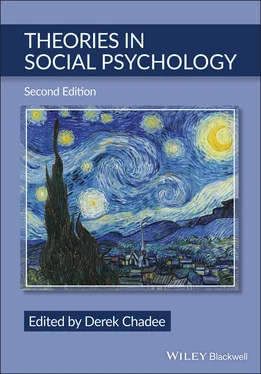Theories in Social Psychology
Здесь есть возможность читать онлайн «Theories in Social Psychology» — ознакомительный отрывок электронной книги совершенно бесплатно, а после прочтения отрывка купить полную версию. В некоторых случаях можно слушать аудио, скачать через торрент в формате fb2 и присутствует краткое содержание. Жанр: unrecognised, на английском языке. Описание произведения, (предисловие) а так же отзывы посетителей доступны на портале библиотеки ЛибКат.
- Название:Theories in Social Psychology
- Автор:
- Жанр:
- Год:неизвестен
- ISBN:нет данных
- Рейтинг книги:5 / 5. Голосов: 1
-
Избранное:Добавить в избранное
- Отзывы:
-
Ваша оценка:
- 100
- 1
- 2
- 3
- 4
- 5
Theories in Social Psychology: краткое содержание, описание и аннотация
Предлагаем к чтению аннотацию, описание, краткое содержание или предисловие (зависит от того, что написал сам автор книги «Theories in Social Psychology»). Если вы не нашли необходимую информацию о книге — напишите в комментариях, мы постараемся отыскать её.
—Robert J. Sternberg,
—Phillip G. Zimbardo, Ph.D., Theories in Social Psychology
Theories in Social Psychology, Second Edition,
Theories in Social Psychology — читать онлайн ознакомительный отрывок
Ниже представлен текст книги, разбитый по страницам. Система сохранения места последней прочитанной страницы, позволяет с удобством читать онлайн бесплатно книгу «Theories in Social Psychology», без необходимости каждый раз заново искать на чём Вы остановились. Поставьте закладку, и сможете в любой момент перейти на страницу, на которой закончили чтение.
Интервал:
Закладка:
The early works on social psychology by the psychologist William McDougall (1908) and the sociologist Edward Ross (1908) weighted social behavior on instinctual or social factors, respectively. Later, Floyd Allport (1924) emphasized a behaviorist stimulus–response paradigm for the understanding of social psychological behavior. Theories of psychology and sociology during this early period seem to have been competing to understand a realm that had neither the theorization nor the research sophistication to claim discovery status. Much of the work undertaken in social psychology has been done within the discipline of psychology, with sociological social psychology contributions being relatively sparse. Notably, the discipline of sociology has contributed tremendously to the early development of the concept and theorization of self, especially via theories of symbolic interactionism, phenomenology, and, later, ethnomethodology. On the other hand, psychological social psychology’s contributions have been crucial to the genesis and development of both the pure and applied branches of the discipline.
Theories often articulate constructs, hypothetical concepts, that allow us to understand phenomena that otherwise would have been impossible to appreciate (see Morgeson & Hofmann, 1999). The human mind in no way can comprehend the complexities of reality. But the assumptions, constructs, concepts, abstractions, hypotheses and propositions within a theory provide a structure to explain dimensions of reality. As the synthesized relationship between a theory and research develops, we gain further understanding into the obscurity of reality. The theory is, then, strengthened with the continuous applications and rigors of scientific testing. The predictive power is often the boast of a good theory. But Waltz (1997, p. 913) cautioned that: “the explanation, not the prediction is the ultimate criterion of a good theory … a theory can be validated only by working back and forth between its implications and an uncertain state of affairs that we take to be the reality against which theory is tested, and that the results of tests are always problematic”.
As Kuhn (1996) has suggested, theory, and by extension knowledge, develops within paradigms. The theories discussed in this volume are evolving within paradigms and contributing to the growth of scientific knowledge. As Kuhn states, a paradigm is “universally recognized scientific achievements that, for a time, provide model problems and solutions for a community of researchers” (1996, p. x). The anomalous research results, vis-à-vis consistent expanding frontiers, derived from testing of theories presented in this volume have not, thus far, created any threats towards a paradigm shift away from the current paradigms under which these theories operate. Theories demonstrate the normal scientific adventure of the movement from pre-paradigm to normal science to revolutionary changes and finally the formation of a new paradigm. Anomalous findings and loss of confidence push resources from one paradigm into a new and emerging paradigm leading to the development and rise of new theorization (Kuhn, 1996).
Many theories are constructed to be tested. But other theories, because of unmeasurable constructs and concepts, are difficult to be evaluated in the Popperian sense of falsification (Popper, 1965). Though falsification is important in the development of scientific theorization it should not be the main criterion for the acceptance or non-acceptance of paradigms. As the famous ship analogy suggests: If you are on a sinking ship with many holes, would you immediately jump into the ocean, or would you wait for another ship to come along? As a critique of falsification, non-confirmation of theories during research does not mean that you should discard the theory and much more, the paradigm within which the theory operates. Rather the output, utility and explanatory power of the theory and paradigm are what sustain the continuance of many theories. But many theories still continue to exert the academic and applied influence even having been exhaustively criticized. Some of the theories presented in this volume are cases in point. Waltz (1997, p. 914) puts it this way, “In contrast, Lakatos observes that “the most admired scientific theories simply fail to forbid any observable state of affairs” (Lakatos, 1970, p. 100). This is true for many reasons. Lakatos himself points out that we always evaluate theories with a ceteris paribus clause implied, and we can never be sure that it holds.” Many social psychological theories are open theories. Popper (1982) argued that open theories expose their propositions, assumptions and hypotheses to constant evaluation, assessment of logical consistency and testing of validity – a process of falsification. A falsification process allows for the continual growth of a theory, and by extension, science.
Social psychology has seen numerous studies testing hypotheses drawn from theories. However, less frequent in the literature is the emergence of theories – a renaissance that is much needed for the development and impetus of the discipline. However, many of the theories that currently exist within social psychology are as important to the discipline as they were over seventy years ago. A renaissance starts with a reassessment of the efficacy of current theories.
Theories have the power of insight and understanding, allowing scientists to see phenomena that previously they would have been unable to conceptualize. Albert Einstein is quoted as saying, “Whether or not you can observe a thing depends on the theory you use. It is the theory which decides what can be observed.” Waltz (1997, p. 913) has given another spin to theorization noting that reality is assembled in the human mind and “the recognition of structures is nothing else than the selective destruction of information”. But what in a theory pushes to, on the one hand, the destruction of information, the blinding of vision, and at the same time allowing us to conceptualize and recognize structures? The construction of theories starts from the limitation of the human mind to discover and understand events, facts, inconsistencies and attempts to discern reality utilizing a systematic process. The epistemological position we adopt allows us to grasp at miniscule aspects of reality. Often, latent within a theory is an epistemological standpoint, whether that be positivism, relativism, realism, constructivism, feminism, existentialism or some other epistemological standpoint. The assumptions, propositions, hypotheses, and supporting confirmed “facts” all provide the theory with a power of vision. The assumptions are givens that the theorist is allowed to utilize in the construction of his theory. They are like the basic tools of a carpenter, in this case the theorist. These assumptions are grounded on some philosophy or principle and are often not the bases on which a theory is criticized. However, assumptions give a theory direction. On the other hand, a theory’s power of vision is myopic, limited by the same tools that give the theory its power. This is a dilemma that the finite scientist must explore in any discipline. However, the beach-ball approach to the understanding of the world within one’s discipline is a compromise accepted by social psychologists. That is, it is recognized that a theory is an academic creation, in this sense, and has limitations. The adoption of a number of theoretical positions provides a more comprehensive understanding of the multidimensional nature of a phenomenon.
A theory can be criticized on a number of grounds, including consistency – how logically well the theory holds together with its propositions and hypotheses; external – standing up to criticisms of other theories (theory A vs. theory B); historical – temporal perseverance of the theory (e.g., does Freud’s psychoanalytical theory or Heider’s attribution theory still hold today?); applicability – the generalizing of findings from research to social situations; and methodological – the strengths and weakness of the methodology used in the construction of the theory.
Читать дальшеИнтервал:
Закладка:
Похожие книги на «Theories in Social Psychology»
Представляем Вашему вниманию похожие книги на «Theories in Social Psychology» списком для выбора. Мы отобрали схожую по названию и смыслу литературу в надежде предоставить читателям больше вариантов отыскать новые, интересные, ещё непрочитанные произведения.
Обсуждение, отзывы о книге «Theories in Social Psychology» и просто собственные мнения читателей. Оставьте ваши комментарии, напишите, что Вы думаете о произведении, его смысле или главных героях. Укажите что конкретно понравилось, а что нет, и почему Вы так считаете.












